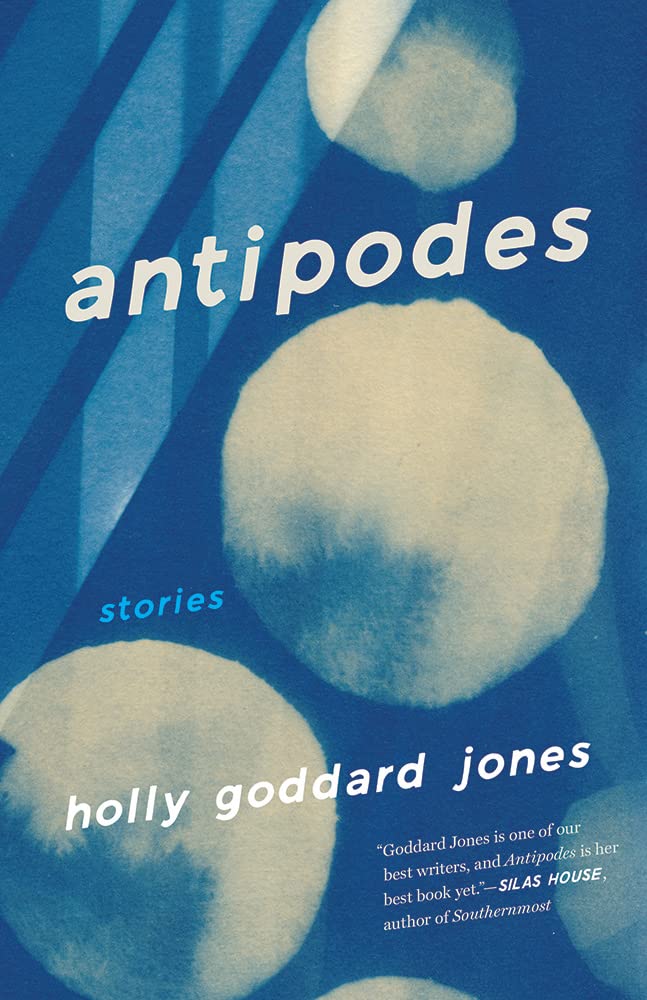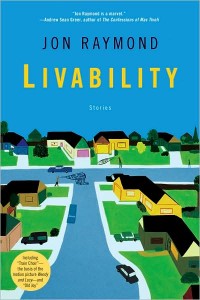 I saw Wendy and Lucy this past April, and there wasn’t any sound for the first ten minutes. Well, not no sound; there were the suggestions of breathing, some ambient rustling. The whispers filling the theater were mainly curious—could this be some new super-indie technique, perfected by director Kelly Reichardt for her second film?
I saw Wendy and Lucy this past April, and there wasn’t any sound for the first ten minutes. Well, not no sound; there were the suggestions of breathing, some ambient rustling. The whispers filling the theater were mainly curious—could this be some new super-indie technique, perfected by director Kelly Reichardt for her second film?
It turned out to be a technical mistake, and I found out what I missed when I read Jon Raymond’s “Train Choir,” the closing piece in his first collection, Livability, and the story on which Reichardt’s film is based. Story-wise, what I missed was crucial: the main character’s motivation to leave her Midwest home for Alaska, how she planned to get there, and what she would do upon arrival. But in the context of the film, the quiet was oddly fitting; Wendy and Lucy was full of those movie silences that are meant to be loaded—and understandably so, since one of two title characters is a dog. But there rarely seemed to be quite enough inside those quiet, suspended moments to bridge one to the next. Reading Raymond’s short stories, though, I was able to better understand how he might have liked them to function.
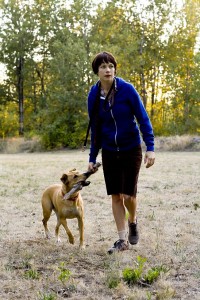
a scene from Wendy and Lucy
Missing from the film, even in some moments when the cinematography was breathtaking, was Jon Raymond’s knack for pinpointing atmosphere. He uses place to capture not only setting but also character, and it’s a good gift to have when a primary concern of your stories is environment: two old friends hike into the Cascade Mountains to find hot springs, a teenaged boy and girl get trapped in the mall overnight, a recent widower goes out to the California coast to channel his wife.
But don’t misunderstand—this isn’t a collection where it rains when the character can’t bring himself to cry; where the rainbow appears at a moment of epiphany. Instead of the old sentimental trick of environmental intervention pointing readers to the appropriate emotion, Raymond’s characters very consciously look to their landscape in order to make sense of their own grief or confusion. Some of the very best moments in Livability happen when location begins to challenge Raymond’s people in this way, and not necessarily for the better.
For example, “The Coast” is the story of a man widowed literally days before he and his wife are to leave for their annual fall trip to a Newport cottage, and he realizes that over the years he “came to imagine Judy and the coast as somehow the same”; no matter what happened during the rest of the year, their trip south and west to that place was a restorative, and one he always counted on. After she dies, then, there couldn’t be a better place to go in order to conjure her, and he goes down to the ocean right away to make an attempt: “I waited for something to happen, but nothing did. Her voice didn’t whisper from the rocks or the sea. The sky didn’t open. I felt no tingles down my spine. I couldn’t say I was surprised, really. Judy was a practical person, and ghostly visitations didn’t seem like her style.” Though the place used to come alive for the narrator and his wife together, it will not necessarily open up immediately to comfort him. This must be all the more painful for the ways in which the coast, in not offering him the solace he wanted, mirrors his wife’s own personality somehow.
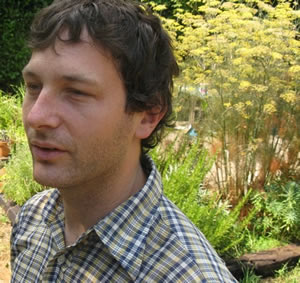
Jon Raymond / photo from Identitytheory.com
These are stories of remembrance and, at times, deep regret. The opening piece, “Old Joy,” follows Mark and Kurt, estranged friends with a long history, on a pilgrimage of sorts to some hot springs Kurt has heard about, and it might well be Raymond at his best in terms of the way environment can parallel emotion. As they hike closer to their destination, Mark feels more and more of something like sympathy for the “shivering” trees around him:
I watched them for a while until an ancient, aching sorrow rose up in my chest. It was a familiar feeling. Something in the mute, unconscious trees resonated inside me, something so deep and fundamental it failed to remember its own source anymore. I watched the poplars flickering against the hard blue of the sky. What is sorrow? I thought. What is sorrow but old, worn-out joy?
Somehow, incredibly, Raymond manages to hold the whole 21-page story in these six sentences: feeling lost in a familiar and static place, the possibility of youth turned into a kind of aimlessness, the bitter pleasure in seeing an old friend. Mark, unlike some of Raymond’s other people, is unable to ignore the ways in which he finds the world reflective of his sadnesses.
What the attention to the natural world and how it affects people seems to lead us toward, in these stories, is the recognition of some sort of inevitability: the world is a depressing place and there is nowhere to turn, no place else to live. In the stories about younger people, environment can also be shifted to mean situation. In “The Wind,” for example, Joseph knows he can’t tell his mother about a fight the neighborhood boys have scheduled him for, but he still hopes for some natural (if unlikely) force to put off the thing altogether. Kendra of “Young Bodies” has already learned she can’t necessarily make a boy like her, but she’s also learned certain ways of putting him at her mercy, and that sometimes that can feel temporarily better:
Late at night all the proscriptions of the day fell away and anything became possible. Fuck his goodness, she thought. Fuck his pity. They were two young bodies in a cage together, and they would do what they pleased.
In many of Raymond’s stories, the inevitabilities with which he presents his characters—dying friendships or deceased spouses, failing careers or fruitless seductions—seem designed to test their mettle and their convictions. And if the things they become are less than desirable, they are at least things one knows how to bear.
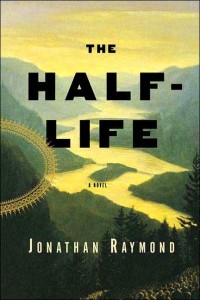
Raymond's first novel
But bearing up is not the same as truly living, and these stories seem to know that. They have a way of stepping slightly out of time to look around themselves and sigh. And we sigh with them, because the majority of Raymond’s people have ostensibly attractive, enviable lives. Lives as artists, screenwriters, print journalists, vagabonds. Lives that should have romance and soul-happiness pre-programmed, but that still aren’t enough, not in reality. And this makes our empathy that much sharper, especially when these characters begin to realize the small ways in which their lives have failed them. Like in “New Shoes” when Dan sees that his movie script is likely going nowhere and even in the face of that letdown he must stay patient with a preteen daughter full of questions. Like in “Words and Things” when Jen finds out her beau’s parents still pay for his car insurance and feels that “a certain mystery slipped away.”
Yet our empathy is not for these somehow-wronged characters; it is more for the stories and situations in general, which are surprisingly nonjudgmental, emotionally. Raymond doesn’t give any instructions or suggestions about whom to sympathize with, often because he doesn’t have to but usually just because he knows it’s not that easy. He seems not to know how to villainize. There’s no easy heartbreak in Livability. There’s no easy way out of anything.
Maybe the most useful reflection for me comes, again, from “The Coast.” After the narrator’s initial attempt to find his wife, he wanders back through town and happens to see an old flame through a restaurant window. After their first run-in (and before their first run-in), he thinks of her back at the cottage, trying to justify his new attraction when he should be mourning: “I figured everyone had this kind of person in their heads. A phantom of missed possibility. An almost lover. We all lived with them, knowing they were just figments of our imagination, but never entirely getting rid of them either.”
This moment seems summary not just of the situation, nor the collection, but all of life. For these phantoms exist not only in the form of our lovers, but all human acquaintances, all things, all opportunities. We think of them because they, in all their absent possibility, are somehow essential to our being and our continuance—they are, yes, essential to our livability. We think of them because we must keep reminding ourselves that we are, in fact, living successfully without them.
Further Resources
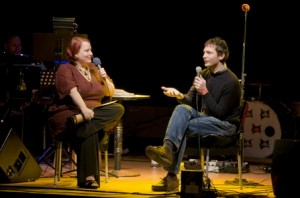
Courtenay Hameister interviews Jon Raymond on Live Wire / photo by Olivia Bucks, for the OREGONIAN
– Here is a profile of Jon Raymond in the Oregonian that focuses in part on the process of his work being made into movies.
– You can also read an interview with Jon Raymond from Identity Theory.
– Or hear Jon Raymond read from Livability for Vanity Fair.
– Here is an excerpt (which you can upload to your mobile phone) from Raymond’s novel, The Half Life.
– Watch a Q & A with Kelly Reichardt and Michelle Williams from the 2008 New York Film Festival, after the debut of Wendy and Lucy.
– You can also read an interview with Kelly Reichardt that Gus Van Sant conducted for Bomb Magazine.
– Here are some excerpts of Jon Raymond reading at Powell’s Books in January:

